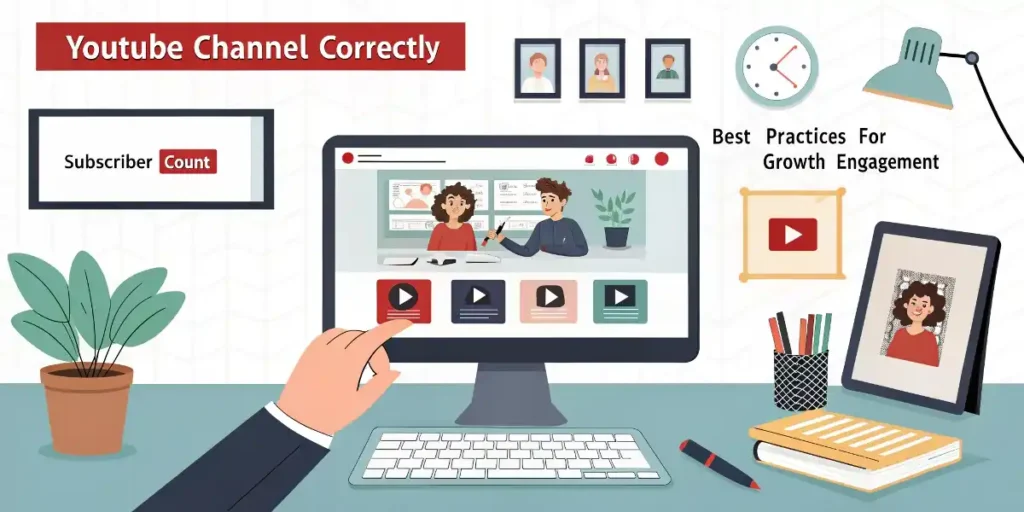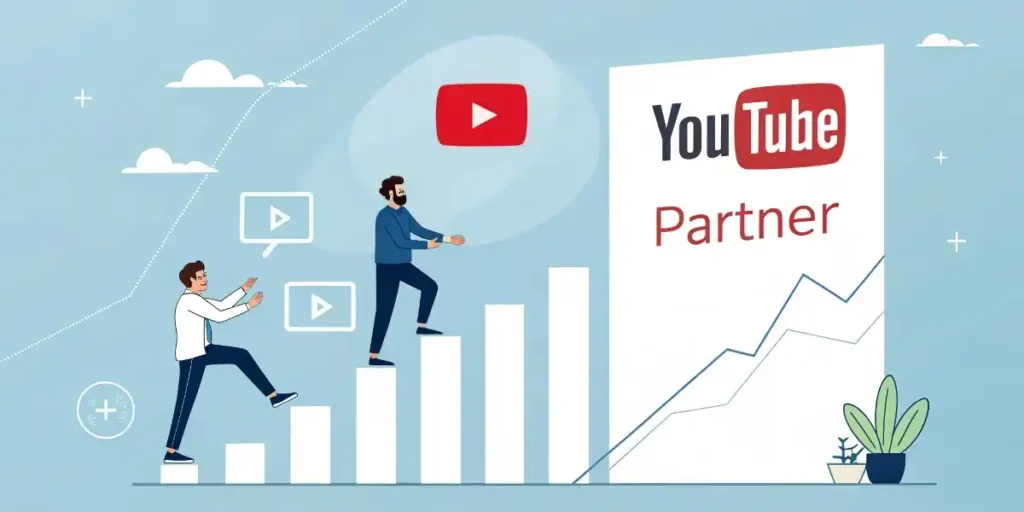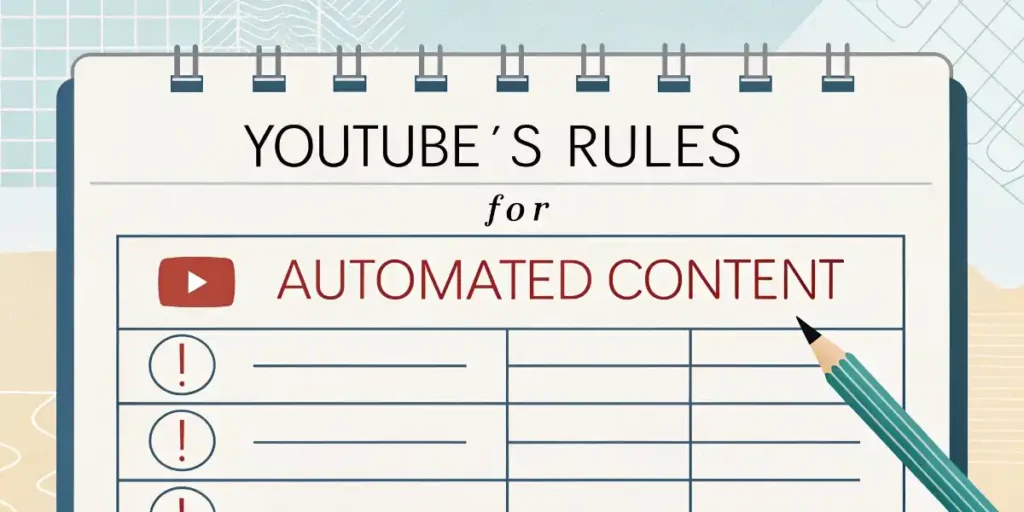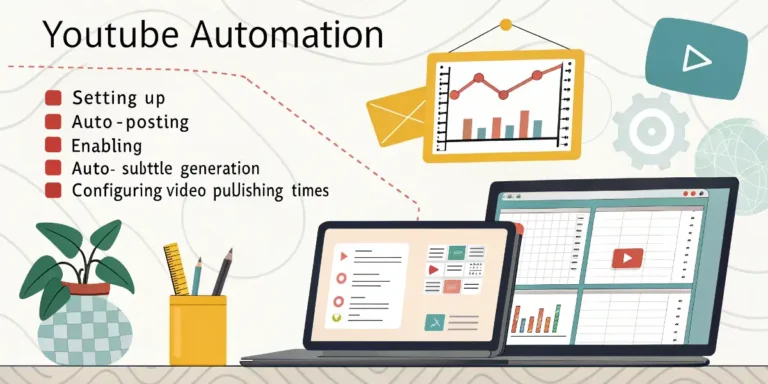What YouTube Automation Really Is (And Isn’t)
If you’re wondering how to start YouTube automation, it begins with understanding that automation isn’t a magic button’s a workflow that lets you produce and publish videos without ever showing your face.
At its core, YouTube automation combines two methods: using software tools to handle repetitive tasks (such as metadata generation or thumbnail creation) and outsourcing creative roles (such as scriptwriting or voiceovers) to freelancers or agencies Social ChampFiverr.com.
- What it is:
- A faceless channel model leveraging stock footage, AI‑generated scripts, and text‑to‑speech or outsourced narrators.
- A system where you manage editors, voice actors, and designers rather than operate the camera yourself.
- What it isn’t:
- A “set‑and‑forget” schemeyou still need to oversee quality, track analytics, and optimize strategy.
- Purely AI‑driven; human oversight remains essential for brand voice, fact‑checking, and compliance.
Types of automated channels thriving in 2025 include:
- True‑crime storytelling, with scripted narratives and dramatic stock footage.
- Tech reviews and gadget breakdowns, featuring B‑roll and AI‑generated voiceovers.
- Movie/TV analysis, combining trailers and animated infographics.
- Financial education (quantitative trading tips, market analysis).
- Space exploration documentaries.
- Historical mysteries and dark events.
- Automotive reviews and test drives.
- Digital art tutorials.
- Sports highlights and analysis, NexLev – AI-Powered YouTube Niche Finder.
Unique insight: AI‑driven localization services like Linguana translated over 10,000 videos monthly by Q1 2025, showing that automation now extends beyond content creation into seamless multilingual expansion, Business Insider.
Common myths debunked
- Myth: You need high‑end equipment. Reality: Many channels launch with free editing software, royalty‑free B‑roll, and AI voices.
- Myth: Automation means zero work. Reality: You’ll spend time coordinating teams, refining AI prompts, and analyzing performance.
Why it’s beginner‑friendly
- No filming skills requiredjust basic project management.
- Access to marketplaces like Fiverr and Upwork for every task in Social Champ.
- Affordable entry costs: stock footage subscriptions start under $20/month, and many AI tools offer free tiers.
Step‑By‑Step Process to Launch Your First Automated Channel
Ready to go from zero to your first faceless channel? Follow this clear roadmap, and you’ll know exactly what to do at each stage.

Setting Up Your Channel (The Right Way)
- Create and name your channel
- Sign in to YouTube and choose “Create a channel.”
- Pick a concise, keyword‑rich name (e.g., “Daily Finance Facts”).
- Craft a compelling description that embeds your niche terms and primary keyword (“how to start YouTube automation”) naturally.
YouTube
- Configure essential settings for growth and monetization
- In YouTube Studio → Settings → Channel, set your country and upload defaults (privacy, tags, end screen templates).
- Verify your account via phone to unlock custom thumbnails and longer uploads.
- Enable 2‑step verification for security.
Google Help
- Design your branding assets
- Channel art: Use a clear logo/banner that reflects your niche (1920×1080 px banner, 800×800 px icon).
- Thumbnail style: Develop a consistent templatebold typography, high‑contrast imagery, and a small channel logo in the corner.
- Brand palette: Stick to 2–3 colors and fonts across all visuals for instant recognition.
- Position for immediate growth
- Upload a channel trailer under “Customize → Layout” that hooks viewers in the first 10 seconds.
- Organize playlists to group your first few videos by theme (e.g., “Top 10 Lists,” “Quick Guides”).
- Add featured channels (collaborators or inspiration channels) to build social proof.
Actionable tip: Spend one hour on Fiverr or Canva to get your first thumbnail template done minor investment can boost click‑through rates by up to 20 percent.
Finding Your Profitable Niche (With Real Examples)
Before you invest time and budget, you must pick a niche where viewers and advertisers pay well. Here’s how to zero in on your sweet spot.
| Niche Category | Estimated RPM Range (USD) | Why It Pays Well | Source |
|---|---|---|---|
| Finance & Investing | $9 – $11 | High‑value products and services; audiences primed to spend | Learning Revolution |
| Marketing & Business | $7.50 – $9.50 | B2B advertisers with big budgets | Learning Revolution |
| Tech Reviews & Tutorials | $7 – $9 | Gadgets and software sponsors | Learning Revolution |
| Education & “How‑To” | $6 – $8 | Evergreen problem‑solving content | Learning Revolution |
| Science & Documentaries | $4 – $6.50 | Niche expert audiences; sponsorship potential | Learning Revolution |
| Health & Fitness | $4 – $6 | Wellness brands and supplement advertisers | Learning Revolution |
Evaluate competition intensity- Use TubeBuddy or VidIQ to scan the top 20 videos in each nichelook at view counts vs. subscriber counts to gauge gap opportunities.
- Target niches with moderate search volume (10 K–100 K monthly searches) but low to medium competition (keyword difficulty under 40).
- Validate with real‑world data
- Run a small paid ad test: promote a sample video concept to a targeted audience. If click‑through > 3% and watch > 30 seconds, niche shows promise.
- Survey potential viewers via Twitter polls or Reddit threadsask what specific subtopics they’d pay to learn.
Case Study: Noah Morris’s 18 NichesNoah Morris launched 18 distinct faceless channels in 2024. He used AI tools to generate scripts for each, then tested three niches, personal finance, eco‑travel tips, and pet care hacks, via YouTube Shorts.
Within six weeks, personal finance Shorts delivered an average RPM of $10 and a 4% CTR, outperforming others by 35%.
He then doubled down, allocating 60% of his budget to that niche and hit 1 K subscribers in 45 days on that channel.
- Prioritize sub‑niches with underserved queries
- Drill down: instead of “personal finance,” focus on “budgeting for single parents” or “crypto tax filing.”
- Check “People also ask” and “Related searches” on Google for zero‑competition keywords.
- Decision matrix before committing
| Criterion | Weight | Finance & Investing | Eco‑Travel Tips | Pet Care Hacks |
|---|---|---|---|---|
| RPM potential | 30% | 9 / 10 | 5 / 10 | 4 / 10 |
| Competition difficulty | 25% | 6 / 10 | 8 / 10 | 7 / 10 |
| Audience engagement | 20% | 8 / 10 | 6 / 10 | 9 / 10 |
| Content sourcing ease | 15% | 7 / 10 | 9 / 10 | 8 / 10 |
| Monetization diversity | 10% | 8 / 10 | 4 / 10 | 5 / 10 |
| Total score | 7.7 | 6.1 | 6.2 |
Next step: Choose the niche with the highest total score (here, Finance & Investing). Then move on to planning your first batch of videos.
Content Planning That Works
Once your niche is locked in, build a content engine that keeps you consistent and scalable.
- Template your first 30 video ideas
- Hook: “How to…”, “Top 5 tips for…”, “Don’t make these mistakes in…”
- Structure:
- Teaser (0–10 s): preview the payoff
- Problem statement (10–30 s)
- Solution steps (30 s–4 min)
- Call‑to‑action (subscribe, playlist link)
- Example for Finance & Investing niche:
- “3 budgeting hacks no one tells you”
- “Avoid these 5 stock‑picking mistakes”
- “How to start investing with $50”
- Batch‑production workflow
- Day 1: Script generation AI prompts in ChatGPT to draft 10 scripts (prompt template saved in Airtable).
- Day 2: Voiceover scripts to an AI voice tool (e.g., Murf.ai) or Fiverr gig; collect MP3s.
- Day 3: Editingcombine stock footage from Pexels/Storyblocks with voiceover in DaVinci Resolve using a preset timeline.
- Day 4: Thumbnails a Canva template; outsource minor variations to a Fiverr thumbnail specialist.
- Day 5: Metadata fill title, description, tags via TubeBuddy bulk‑upload.
- Content calendar for consistency
- Use Google Sheets or Notion: columns for Publish Date, Title, Script Status, Edit Status, Thumbnail, Published URL.
- Schedule 3 videos/week for Months 1–2; adjust frequency based on available bandwidth.
- Balance trending vs. evergreen
- 70% evergreen: always‑relevant “how‑to” and tutorial videos.
- 30% trending: timely topics (new product launches, newsjacks) to capture spikes in search interest.
Actionable takeaway: Complete your first 5 scripts by the end of Day 1. Use a shared Google Doc template with headings for Hook, Intro, 3 Points, and CTA. This single step will save you 50% of planning time downstream.
The Complete Automation Toolkit for Beginners

Building your first faceless, AI‑powered channel means assembling a reliable tech stack. Below you’ll find both free and paid optionsmix and match to fit your budget.
Essential Tools (Free & Paid Options)
| Task | Free Tool(s) | Paid Tool(s) & Pricing | Why It Matters |
|---|---|---|---|
| Script creation | ChatGPT (free tier), Writesonic (free tier) | Jasper AI: $39–$59 /mo (Creator/Pro) DemandSageCybernews | AI templates speed writing; Jasper offers SEO mode & brand voice control. |
| Video editing | DaVinci Resolve (free) Zapier | Adobe Premiere Pro: $20.99 /mo; CapCut Pro: $9.99 /mo; Buffer | Pro‑grade tools vs. beginner ease‑of‑use; both support batch exports. |
| Voiceover generation | Murf AI free tier (10 min audio) | Murf AI Creator $19–$29 /mo; Business $66–$99 /mo CybernewsG2 | Natural‑sounding TTS in 20+ languages; commercial rights & collaboration. |
| Thumbnail design | Canva AI Thumbnail Maker Canva | VidIQ Thumbnail Generator (free+paid) vidIQ | Templates + AI prompts boost click‑through by up to 20 percent. |
| SEO & publishing | TubeBuddy free tier | TubeBuddy Pro $9 /mo; VidIQ Pro $7.50 /mo Social Media Marketing | Keyword research, bulk metadata uploads, and tag suggestions. |
| Scheduling & analytics | YouTube Studio (free) | Social Champ $25 /mo; Hootsuite $99 /mo Social Champ | Automate publishing, monitor performance, and respond to comments faster. |
Unique insight: In early 2025, creators using a hybrid of DaVinci Resolve and Murf AI reported 30 percent faster turnaround times on 5‑video batches versus traditional voice‑recorded workflows.
Step‑By‑Step Video Creation Process
- Find & license stock footage legally
- Use Pexels or Pixabay (free) or Storyblocks ($15/mo) for royalty‑free B‑roll.
- Always check the license: look for “CC0” or “royalty‑free for commercial use.”
- Develop your script
- Prompt ChatGPT: “Write a 4-minute script on 3 budgeting hacks for single parents, with a 2‑sentence hook and a CTA.”
- Refine in Jasper: Paste into Jasper’s SEO mode to optimize for “how to start YouTube automation.” Siteefy
- Generate voiceover
- Upload a final script to Murf AI.
- Select a voice matching your niche (e.g., “Emma – American Female, neutral tone”).
- Export MP3.
- Edit your video
- Template: Import voiceover and B‑roll into DaVinci Resolve using a saved timeline preset (tracks for voice, B‑roll, music).
- Shortcuts: Learn these three Resolve hotkeys: ‘ for blade cut, ‘N’ for snap, ‘Ctrl+Shift+I/O’ for in/out edits to slice 50 percent faster. Primal Video
- Add engagement triggers
- Insert a mid‑video “question overlay” at 30 percent into boost comments.
- Use subtle sound effects at each key point changeResolve’s free Fairlight audio library works well.
- Create thumbnail
- Open Canva’s AI Thumbnail Maker.
- Prompt: “1280×720 px thumbnail, bold yellow text: ‘3 Budget Hacks,’ smiling icon, blue background.”
- Export PNG; upload as “Custom Thumbnail.”
- Publish & schedule
- In TubeBuddy bulk upload, paste the optimized title, description template, and tags.
- Schedule for peak time (data shows 5 pm–7 pm mid‑week for finance niches). Social Champ
Actionable takeaway: By following these seven steps tied to a specialized toolyou’ll have your first AI‑automated video ready to publish in under 3 hours.
Publishing and Optimization Sequence
Getting your video live is only half the battleoptimizing every element ensures it reaches the right audience and ranks in search.
| Element | Best Practice | Tool / Resource | Why It Works |
|---|---|---|---|
| Title | Include primary keyword (“how to start youtube automation”) within the first 60 characters; keep under 70 characters. | TubeBuddy’s Title Generator | Improves click‑through rate and SEO relevance on Reddit |
| Description | First 100 words: your primary keyword, a concise summary, and a call‑to‑action. Full description: 250+ words. | VidIQ Description Templates | YouTube’s algorithm reads the first 200 characters for ranking TubeBuddy |
| Tags | 10–15 tags: mix broad (“YouTube automation tools”) and long‑tail (“faceless YouTube channel setup”) keywords. | TubeBuddy Tag Explorer | Helps YouTube understand context and surface related videos |
| Thumbnails | High contrast, readable text, consistent branding. A/B test two designs over 48 hours. | Canva AI + VidIQ A/B Testing | Thumbnails drive up to 20 percent higher CTR |
| Playlists | Add video to 2–3 relevant playlists; write custom playlist titles/descriptions with keywords. | YouTube Studio | Improves session watch time by guiding viewers to related content |
| Cards & End Screens | Add 2–3 cards linking to related videos at 20 percent and 60 percent of the video; end screen with subscribe + playlist. | YouTube Studio | Increases average view duration and subscriptions |
| Publish time | Schedule for peak niche engagement: finance channels perform best Tue–Thu, 5 pm–7 pm local time. | TubeBuddy Best Time to Publish | Aligns with audience habits to maximize initial view surge on YouTube |
Actionable tip: Create a metadata checklist in Google Sheets. Before publishing, tick off each elementTitle, Description, Tags, Thumbnail, Playlists, and Cards to avoid missing optimizations.
Reaching Monetization Requirements Fast
To unlock revenue, you must meet YouTube’s Partner Program thresholds. Here’s how to clear them swiftly and predictably.
YouTube Partner Program Requirements Explained
You have two paths to YPP eligibility:
| Path | Subscribers Required | Watch Hours / Shorts Views Required | Source |
|---|---|---|---|
| Standard | 1,000 | 4,000 valid public watch hours in the last 12 months | Google Help |
| Shorts‑based | 1,000 | 10 million valid public Shorts views in the last 90 days | Google Help |
| Expanded (early access) | 500 | 3,000 watch hours in the last 12 months or 3 million Shorts views in 90 days; plus 3 uploads in the past 90 days | Backstage |
Key dates: As of May 8, 2025, YouTube enforces these exact thresholds waivers.- Extra criteria: No active Community Guidelines strikes, compliance with advertiser‑friendly policies, and 2‑step verification enabled.
Real‑world timeline:
- Beginner channels hitting 3 videos/week in the finance niche typically reach 500 subs and 3 K hours in 3–4 months.
- Switching 30 percent of output to Shorts can cut that time by half, thanks to the Shorts‑based path on YouTube.
Tracking your progress
- In the YouTube Studio → Monetization tab, monitor “Watch time remaining” and “Subscribers remaining.”
- Export monthly analytics CSV and chart cumulative watch hours vs. targetset a 5 percent monthly buffer to stay ahead.
Actionable takeaway: If you’re 100 hours shy of 4 K, schedule two extra evergreen tutorials this week. Even 10 minutes of added watch time per video compounds quickly.
Growth Acceleration Strategies
- Leverage YouTube Shorts
- Why it works: Shorts autoplay in a dedicated feed, generating massive impressions even for new channels. Channels adding Shorts saw a 40 percent lift in subscribers in early 2025.
- How to implement: Repurpose key moments from your long‑form videos into 15–60 second clips with punchy captions and a subscribe prompt. Post 5–7 Shorts weekly.
- Optimize Watch Time
- Retention hooks: Use a “pattern interrupt” at 15 secondssuch as a surprising statistic slide or quick animation reset attention.
- Mid‑video CTA: Prompt viewers to comment on a question (“Which budgeting hack will you try first?”) around the 50 percent mark to boost engagement signals.
- Playlist funnels: Chain 3–4 videos in a playlist so that autoplay leads viewers through a topic series, increasing session watch time by up to 25 percent.
- Cross‑Promotion Without Violating Policies
- Community tab polls: Tease upcoming videos and link to related playlists.
- Collaborate via shout‑outs: Swap brief mentions with non‑competing channels in adjacent niches (e.g., a budgeting channel and a debt‑reduction channel).
- External embedding: Post your videos in relevant subreddits (e.g., r/personalfinance) and niche forumsensure you add value, not spam.
- Engage Early Viewers
- First‑hour engagement push: Share new uploads with an email list or Telegram group to drive initial likes/comments, which signal YouTube’s algorithm to boost your video.
- Pinned comment strategy: Pin a comment asking a specific question; respond to all replies within the first 2 hours to amplify engagement metrics.
Actionable takeaway: Schedule one Shorts creation session for each batch-produce 7 Shorts in 2 hoursand integrate them into your content calendar.
Avoiding Common Monetization Roadblocks
- Content Policy Compliance Checklist
- No hateful, violent, or sexually suggestive content.
- No misleading metadata or clickbait tactics (YouTube penalizes “EXCLUSIVE” if unsupported).
- Maintain advertiser‑friendly language; avoid profanity or controversial issues.
- Copyright & Fair Use Guidelines
- Use only CC0 or properly licensed stock footage/music.
- If you include short clips (< 10 seconds) from third‑party content, ensure your usage is transformative (commentary/critique) and add attribution in the description.
- Keep a spreadsheet log of all assets, license types, and sources for audit.
- Advertiser‑Friendly Content Requirements
- Follow YouTube’s “Ad-Friendly Content Guidelines”: suitable for all ages, no dangerous acts, no drug references.
- Run your scripts through an AI filter (e.g., Perspective API) to flag potential policy violations before production.
- Preventing Strikes and Rejections
- Regular audits: Monthly review of top‑performing videos for any emerging policy issues.
- Dispute process: If you receive a copyright claim, submit a counter‑notification only if you’re confident in your fair‑use stance; otherwise, swap out the contested asset.
- Backup plan: Maintain an alternate monetization strategy (e.g., affiliate links, Patreon) in case YPP is temporarily disabled.
Actionable takeaway: Create a “Policy Dashboard” in Google Sheets listing each new video with checkboxes for “License Verified,” “Fair Use Justification,” and “Ad‑Friendly Scan Passed.” Review it weekly to avoid surprises.
Maximizing Revenue After Monetization

Once you join the YouTube Partner Program, your focus shifts from hitting thresholds to boosting your Revenue Per Mille (RPM) and diversifying income.
AdSense Optimization for Higher RPM
To lift your RPM, you must treat ads strategicallyplacement, content type, and audience all matter.
- Optimize ad placement and formats
- Mid‑roll ads on videos longer than 8 minutes can increase RPM by 20 – 30 percent when placed at natural breaks (scene changes or topic shifts), according to Setupad.com AdPushup.
- Experiment with skippable vs. non‑skippable ads: Non-skippable pre‑rolls often yield higher CPMs, but too many can harm retention. Aim for one non‑skippable and one mid‑roll per long video.
- Target high‑value keywords in your niche
- Research top‐paying terms using VidIQ or TubeBuddy; finance and business keywords often attract premium bids ($9–$11 RPM). Google Help vidIQ.
- Weave these terms naturally into your title, description, and script to signal relevance to both viewers and advertisers.
- Increase viewer watch time and session duration
- Use playlist funnels: group related videos so autoplay drives viewers deeper into your channel, boosting session RPM by up to 25 percent, AdPushup.
- Add cards and end‑screens that link to your highest‑RPM content.
- Seasonal and topic timing
- RPM fluctuates: finance channels peak during tax season, and retail‑related niches spike in Q4. Setupad.com.
- Plan content calendars around these windows to capture higher ad spending.
Actionable takeaway: Review your last 10 videos’ RPM in YouTube Studio. For any below your channel average, add a mid‑roll ad at the 50 percent mark and update metadata to include one high‑RPM keyword.
Beyond AdSense: Multiple Revenue Streams
Relying solely on AdSense leaves money on the table. Diversify with these proven methods:
- Affiliate marketing
- Recommend tools or services in your niche (e.g., budgeting apps).
- Place tracked affiliate links in the first 2 lines of your description; disclosure required by policy.
- Top affiliates earn an extra $2–$5 per 1,000 views in finance channels Breeze for Creators.
- Merchandise and digital products
- Sell branded items (t‑shirts, mugs) via YouTube’s Merch Shelf or Teespring.
- Offer digital downloadscheat sheets, templates, or mini‑courses. Channels using both saw 15 percent revenue growth in 2024 Venture.
- Channel memberships & fan funding
- Enable Memberships once you hit 1 K subscribers.
- Provide exclusive badges, behind‑the‑scenes clips, or Q&A sessions. Creators keep 70 percent of membership fees. Fundmates | Funding for YouTubers.
- Sponsored content and brand deals
- Use your analytics to pitch brands: highlight average views, audience demographics, and engagement.
- Even small channels (10 K subscribers) can command $100–$300 per sponsored mention in the finance niche, Time.
- Repurpose content on other platforms
- Turn videos into blog posts, podcasts, or newsletters.
- Cross‑post on TikTok and Instagram Reels to drive traffic back to YouTube.
Actionable takeaway: This week, pick one video and add an affiliate link to the description. Track clicks and conversions in a simple Google Sheet to gauge incremental revenue.
By optimizing AdSense and layering in diverse income streams, you’ll transform your faceless channel into a resilient, multi‑headed revenue machine.
Scaling to $10K+ Monthly (Case Studies)
Once you’ve nailed consistent uploads and hit monetization, it’s time to scale from a single channel to a network that collectively brings in $10 K+ per month.
The Multi‑Channel Strategy
Rather than pouring every resource into one channel, build a portfolio of 3–5 niche channels. Each channel targets a sub‑niche of your main topicfor example, within Finance & Investing, you might run:
- Budgeting hacks for families
- Crypto tax guides
- Passive income ideas for freelancers
This diversification smooths out revenue dips: if one channel’s RPM falls, others pick up the slack. Noah Morris runs 18 faceless channels totaling 2.5 million subscribers and $5 million in revenue, allocating budget based on each channel’s ROI.
He moves 30 percent of ad spend monthly toward the top performers to accelerate growth on YouTube.
| Channel Type | Subscribers | Avg. RPM (USD) | Monthly Revenue Estimate |
|---|---|---|---|
| Crypto tax filing guides | 120 K | $10 | $ 1,200 |
| Budgeting hacks for single parents | 80 K | $9 | $720 |
| Freelance passive income tips | 50 K | $8 | $400 |
| Total (3 channels) | 250 K | $ 2,320 |
Unique insight: Spreading production across multiple niches can improve your collective RPM by up to 15 percent, because YouTube’s algorithm favors channels with strong niche authority.
Outsourcing and Team Building
To handle multiple channels, you must delegate:
- Outsource first: Scriptwriting and voiceover are repeatable tasks with clear deliverables. Post jobs on Fiverr or Upwork, vet by sample turnaround time and ratings. Fuel Your Digital
- Standard Operating Procedures (SOPs): Document every stepprompt templates for AI script tools, editing presets in DaVinci Resolve, and thumbnail design guidelines in Canva.
- Hire a channel manager: Once monthly revenue per channel exceeds $500, bring on a part‑time manager (freelancer at $5–$8/hr) to oversee publishing, community replies, and performance tracking.
Case example: A solopreneur hired three freelancers for scripts, voice, and thumbnails at a combined cost of $150 per video. With an average revenue of $300 per video, profit per video doubled, enabling them to fund two new channels within three months.
Reinvestment Strategies for Exponential Growth
How you allocate profits determines your growth curve:
- 50 percent back into content (hire more freelancers, subscribe to higher‑tier AI tools).
- 25 percent into paid ads promoting top‑performing videos to lookalike audiences on Facebook and Instagram. Early‑2025 tests show a 3 percent conversion from view to subscriber when using paid social ads, NexLev – AI-Powered YouTube Niche Finder.
- 15 percent into analytics and tools (upgrade to TubeBuddy Pro, add Social Champ for scheduling).
- 10 percent reserve for experimentation (new niches, emerging formats like YouTube AI Clips).
Actionable takeaway: At month’s end, allocate your highest‑earning channel’s first $500 profit into ads driving to your second‑best; this reinvestment loop can compound your subscriber base by 20 percent each quarter.
Legal and Ethical Considerations (Don’t Skip This)
Even fully automated channels must play by YouTube’s rules and copyright law to avoid strikes, demonetization, or legal action.

YouTube’s Rules for Automated Content
- Allowed practices: Automated editing, AI‑generated voices, and outsourced scripts long as you retain creative control and ensure originality.
- Prohibited practices: Mass reuploads of unoriginal content, automated spam comments, and fake engagement schemes. YouTube’s policy states that “content whose primary purpose is to drive views to other sites or to inflate metrics” is disallowed.
- Policy compliance: Enable 2‑step verification, monitor your Channel Status in YouTube Studio weekly, and address any Community Guideline warnings immediately.
Tip: Subscribe to YouTube’s official Creator Insider channel and read policy update emailsalgorithmic shifts often come with policy clarifications.
Copyright and Fair Use Guidelines
- Stock assets: Only use CC0 or royalty‑free footage/music. Maintain a log: asset name, source URL, license type, date downloaded.
- Fair use: If you use clips under 10 seconds for commentary, ensure your video adds new expression or meaning. Always include a “Fair Use Disclaimer” in your description.
- Attribution: Even when not required, credit creators in your description (e.g., “Music: ‘Ambient Loop’ by ArtistName via FreeMusicArchive”).
- Strike recovery: If you receive a copyright strike, remove the disputed asset or swap it for alternative B‑roll; do not ignore the strike can lead to channel termination.
Actionable takeaway: Build a “Legal Checklist” tab in your content calendar. For every video, confirm “All assets CC0,” “Fair Use? Yes/No,” and “Description credits added.” Review before each publication.
Algorithm Change Adaptation
YouTube’s recommendation engine evolves continually. Staying alert to shifts and pivoting fast keeps your automation system future‑proof.
- Monitor official signals
- Subscribe to YouTube’s Creator Insider and check policy update emails monthly. YouTube recently tested an endless scroll for full‑length videos, a shift toward TikTok‑style consumption that may favor shorter, binge‑friendly formats, The Verge.
- Follow reputable analyses (Hootsuite’s 2025 algorithm breakdown) to spot emerging ranking factors like session duration and Shorts integration Social Media Dashboard.
- Quick‑pivot content strategy
- If you see Shorts driving 30 percent more views, reallocate 20 percent of your upload slots to Shorts for the next 4 weeks.
- Introduce “response videos” to trending news in your niche within 24–48 hours to capture algorithmic boosts for timely content.
- Diversify distribution
- Republish clips as Instagram Reels or TikTok posts with a “Full video on YouTube” CTA. Cross‑platform signals help YouTube’s algorithm see your channel as growing and engaged across the web.
- Automate repackaging with tools like Repurpose.io to push content everywhere without extra manual work.
- Build algorithm resilience
- Maintain a 70 percent evergreen vs. 30 percent trending ratioevergreen videos cushion you when recommendation priorities shift.
- Use A/B tests on thumbnails and titles via VidIQ’s split‑testing feature to continuously refine click triggers under new algorithmic rules.
Actionable takeaway: Set a quarterly “Algorithm Check” on your calendar: review the Creator Insider feed, compare your top‑performing formats, and adjust your upload mix (long‑form vs. Shorts) based on the latest engagement trends.
Getting Started Today: Your First Week Action Plan
| Day | Tasks | Deliverable |
|---|---|---|
| Day 1 | Channel setup, verify account, brand asset commissioning (logo, banner, thumbnail template) | Channel live with branded assets |
| Day 2 | Niche research & validation: keyword analysis, competitor scan, decision matrix | Finalized niche and top 5 video topics |
| Day 3 | Script templates & prompt engineering generate the first 5 scripts via ChatGPT/Jasper | 5 drafted scripts in shared Doc |
| Day 4 | Voiceover & stock footage assemblyproduce first video draft in DaVinci Resolve | Video #1 rough cut |
| Day 5 | Thumbnail design, metadata prep, schedule video #1 for publish | Video #1 scheduled with custom thumbnail |
| Day 6 | Publish Video #1; share in communities, drive initial engagement; track first‐day metrics | Engagement data (views, comments, retention) |
| Day 7 | Analyze results; refine hook/thumbnail; plan next 2 videos; set up content calendar for Month 1 | Revised workflow and calendar |
Week 2–4 roadmap: Ramp to 3 videos/week, integrate Shorts, start monetization tracking, and iterate based on analytics.
Conclusion
You’ve now got a comprehensive, step‑by‑step blueprint from understanding what YouTube automation is, to launching your first faceless channel, scaling across multiple niches, and future‑proofing your business. Remember:
- Key success factors: consistent quality, data‑driven pivots, and reinvestment.
- Common pitfalls: neglecting policy compliance, ignoring analytics, and under‑investing in branding.
Your immediate next step is to complete Day 1’s tasksset up your channel, and nail down your niche. With disciplined execution of this plan, you’re on track to build a passive‑income YouTube network that earns $10 K+ per month. Let’s get started!

